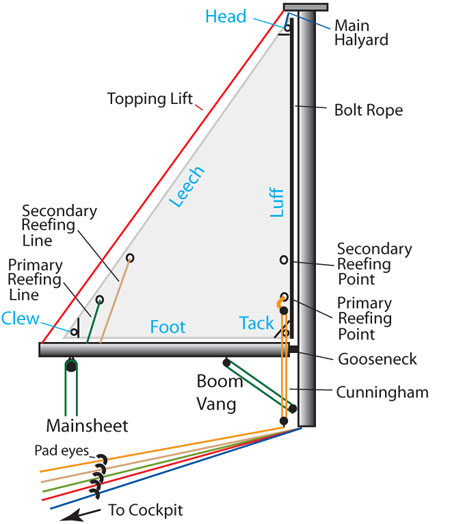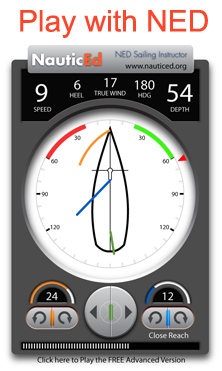This is a continuing learning how to sail article on Reefing the Sails. This has been written by Grant Headifen of NauticEd Sailing School.
In the last Learn to Sail article on reefing we convinced you pretty hard on why you should reef the sails. So now let’s first learn how to reef the headsails.
The five most common sails on a sailboat are mainsail, jibsail, genoa, spinaker and genaker.
We’ll deal with the spinnaker and genaker first in regards to reefing because it’s pretty simple. Take them down and replace with a smaller one if available or take down entirely. Don’t push the limits with these sails. They are made of very fine and fragile fabric because they need to be light. If you over power these sails they will tear. Even if they don’t tear, one slight misjudgment or distraction when flying these in high winds can lead to a broach and broaches are bad.
A broach is when the wind force slams the boat over sideways, you loose control, the boat tries rounds up but the wind continues to fill the sail and hold the boat down – potentially capsizing it. It’s the last thing you want to do as you learn to sail because you probably don’t have the experience to get out of this situation other than swimming. You’ll most often see this in yacht club regatta racing when a captain is reluctant to reduce sail area because he wants to win the race. Experienced skippers know to NOT put a stopper knot in any of the working lines of a spinnaker or genaker. If you broach, you will need to dump these lines completely out of any blocks or fairleads that guide these lines with in seconds or face potential capsize.
The next sail set to discuss is the jibsail and the genoa. Or they can correctly be referred to as the head sail in both circumstances. These two sails are essentially the same except by definition. A headsail is a genoa if the clew (bottom aft eyelet) extends aft past the mast. A head sail is a jibsail if the clew does not extend past the mast. People refer to a jib or genoa size by the percentage of distance from the forestay to the mast. If the Genoa extends past by 10% then it is called a 110 genoa. If a jibsail extends only 90% of the distance from the forestay to the mast then it is called a 90 jibsail.
Some jibsails and genoas are raised and lowered and some roll up (furl) around the forestay. If they are furled around the forestay then it is very simple to reef them. You simply roll them up a little in order to decrease their size. Typically there will be two stripes marked on the foot of the jib/genoa. Each one marks where the sail should be rolled to for the respective reefing point.
There is a safety and rigging protecting method that is VERY important to note when reefing a roller furling sail. It’s a classic mistake that is commonly made when you learn to sail because you’re not familiar with the rigging and their forces. The point is simple, you must tighten the sail after reefing with the jibsheet. Don’t use the inhaul to tighten the sail. A roller furling jibsail/genoa has a drum at the bottom of the forestay. This rolls up by pulling on the inhaul line and rolls out by pulling on the jibsheet. The inhaul is a line that runs back to the cockpit. You pull the inhaul to wind it up while managing the slow release of the jib sheets.
To unwind the head sail you will release the inhaul line and lay it out so that it will uncoil smoothly with out getting caught in the inhaul clutch or cleat. Then pull the leeward (downwind) jibsheet all the time ensuring the smooth uncoiling of the inhaul, plus keeping a watch out on traffic and crew etc.
When you are reefing a roller furling headsail, slowly let out the jibsheet while heading the boat slightly to wind to slacken the jibsheet. Roll up the sail the desired amount making sure that the jibsheet always has some slack to it. Then tighten the headsail back up with the jibsheet only. Do not cleat off the jibsheet and tighten the sail by further hauling in on the inhaul. This will certainly damage the drum and furling system.
For additional safety, do not completely let go the jibsheets then begin winding the inhaul. This causes the jibsheets to whip wildly and, from experience, they really REALLY hurt. Control the jibsheet tension at all times. Controlling the jibsheet tension also ensures a firmly wound headsail.
When you want to let out a reef in the headsail, first wrap the inhaul around a winch two to four times depending on the wind strength. Then release the inhaul clutch/cleat and control the let out of the inhaul. Once it is at the point you want it or it’s all the way out, cleat the inhaul and tighten up on the jibsheet.
If the headsails are not of the furling type then you will most likely hank (clip) them onto the forestay and then raise the sail with the jib halyard. In this case there is no way to furl or reef that sail. Reefing the headsail then means removing the current headsail and raising a smaller one. It’s not that difficult but you have to be aware of whipping lines and inherent dangers of being on the bow in rough and rolling seas with waves potentially breaking over the foredeck. Under poor weather conditions, the prudent sailor will be clipped into jacklines with a harness. Jacklines are safety lines that run on the deck from forward to aft. A crew member can clip in and walk to the foredeck and back whilst all the time being attached to the sailboat.
As you learn to sail, we sincerely hope that you take note of this sail reefing series as it is very important to your crew, yourself and your vessel. This article is not the be all and end all. You absolutely should get out sailing with a knowledgeable friend or instructor from a NauticEd Affiliated sailing school on a boat and practice reefing under various weather conditions.
This learn to sail article was written by Grant Headifen, Educational Director of NauticEd. NauticEd is an online sailing school providing sailing courses and sailing certifications for beginner to advanced sailors worldwide.
NauticEd Sailing Certifications are accepted by most large yacht charter companies including The Moorings, Sunsail, Kiriacoulis, BVI Yacht Charters, Sailing New Zealand, Gulf Charters Thailand.


